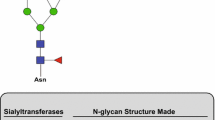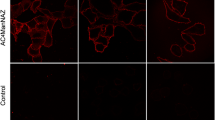Abstract
Sialic acid residues are the most abundant terminal carbohydrate residues of mammalian cells. Modification of the sialic acid residues by exposure of cells in culture to sialic acid precursor analogues resulted in a modifed susceptibility to polyoma viruses. In the present study, human breast and colon cancer cell lines were exposed for 65 h to these acid precursor analogues at 5 mM and their lectin binding pattern was analysed. Use of a panel of several different lectins indicated that the pretreatment of these cell lines with the sialic acid analogues did not change their lectin binding profile. The incorporation of these precursors into membrane glycoproteins was assessed by reversed phase high-performance liquid chromatography, which clearly demonstrated that the precursors were incorporated. The results therefore indicate that these analogues are highly specific for sialic acid and do not interfere with other biosynthetic pathways of membrane glycoconjugates.
Similar content being viewed by others
Refrences
Brooks SA, Leathem AJC (1991) Prediction of lymph node involvement in breast cancer by detection of altered glycosylation in the primary tumor. Lancet 338:71–74
Brooks SA, Lymboura M, Schumacher U, Leathem AJ (1996) Histochemistry to detectHelix pomatia binding in breast cancer: methodology makes a difference. J Histochem Cytochem 44:519–524
Fiedler K, Simons K (1995) The role ofN-glycans in the secretory pathway. Cell 81:309–312
Gaffney EV (1982) A cell line (HBL-100) established from human breast milk. Cell Tissue Res 227:563–568
Gallagher JT, Morris A, Dexter TM (1985) Identification of two binding sites for wheat germ agglutinin on polylactoseamine-type oligosaccharides. Biochem J 231:115–122
Hara S, Takemori Y, Yamaguchi M, Nakamura M, Ohkura Y (1987) Fluorometric high-performance liquid chromatography ofN-acetyl- andN-glycolylneuraminic acids and its application to their microdetection in human and animal sera, glycoproteins and glycolipids. Anal Biochem 164:138–145
Keppler OT, Stehling P, Herrmann M, Kayser H, Grunow D, Reutter W, Pawlita M (1995) Biosynthetic modulation of sialic acid-dependent virus-receptor interactions of two primate polyoma viruses. J Biol Chem 270:1308–1314
Kobylka D, Carraway KL (1972) Proteins and glycoproteins of the milk fat globule membrane. Biochim Biophys Acta 288:282–295
Kornfeld R, Kornfeld S (1985) Assembly of asparagine-linked oligosaccharides. Annu Rev Biochem 54:631–664
Leathem AJ, Brooks SA (1987) Predictive value of lectin binding on breast cancer recurrence and survival. Lancet I:1054–1056
Mitchell BS, Vernon K, Schumacher U (1995) Ultrastructural localization ofHelix pomatia agglutinin (HPA)-binding sites in human breast cancer cell lines and characterization of HPA binding glycoproteins by western blotting. Ultrastruct Pathol 19:51–59
Plendl J, Schönleber B, Schmahl W, Schumacher U (1989) Comparison of the unmasking of lectin receptors by neuraminidase and by enzyme free buffer alone. J Histochem Cytochem 37:1743–1744
Schauer R (1985) Sialic acids and their roles as biological masks. Trends Biochem Sci 10:357–360
Schumacher U, Higgs D, Loizidou M, Pickering R, Leathem A, Taylor I (1994)Helix pomatia agglutinin binding is a useful prognostic indicator in colorectal carcinoma. Cancer 74:3104–3107
Schumacher U, Adam E, Brooks SA, Leathem AJ (1995a) Lectin-binding properties of human breast cancer cell lines and human milk with particular reference toHelix pomatia agglutinin. J Histochem Cytochem 43:275–281
Schumacher U, Adam E, Brooks SA, Leathem AJ (1995b) Development of clinically relevant models of metastasis using SCID mice and lectin defined human cancer cells. Surg Radiol Anat 17:228
Varki A (1992) Diversity in the sialic acids. Glycobiology 2:25–40
Walker RA (1993)Helix pomatia and the prognosis of breast cancer. Br J Cancer 68:453–454
Author information
Authors and Affiliations
Rights and permissions
About this article
Cite this article
Schumacher, U., Mukhtar, D., Stehling, P. et al. Is the lectin binding pattern of human breast and colon cancer cells influenced by modulators of sialic acid metabolism?. Histochem Cell Biol 106, 599–604 (1996). https://doi.org/10.1007/BF02473276
Accepted:
Issue Date:
DOI: https://doi.org/10.1007/BF02473276




